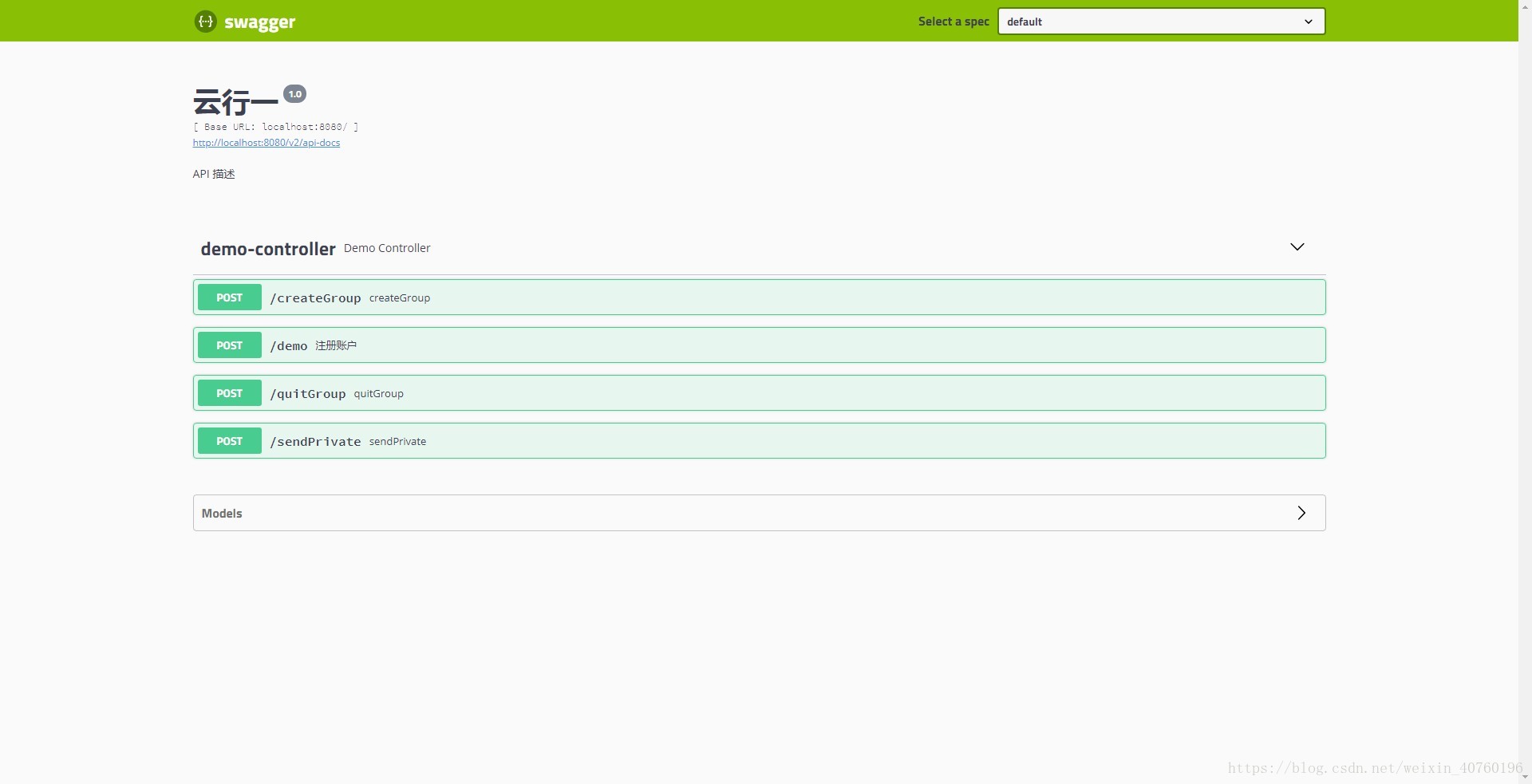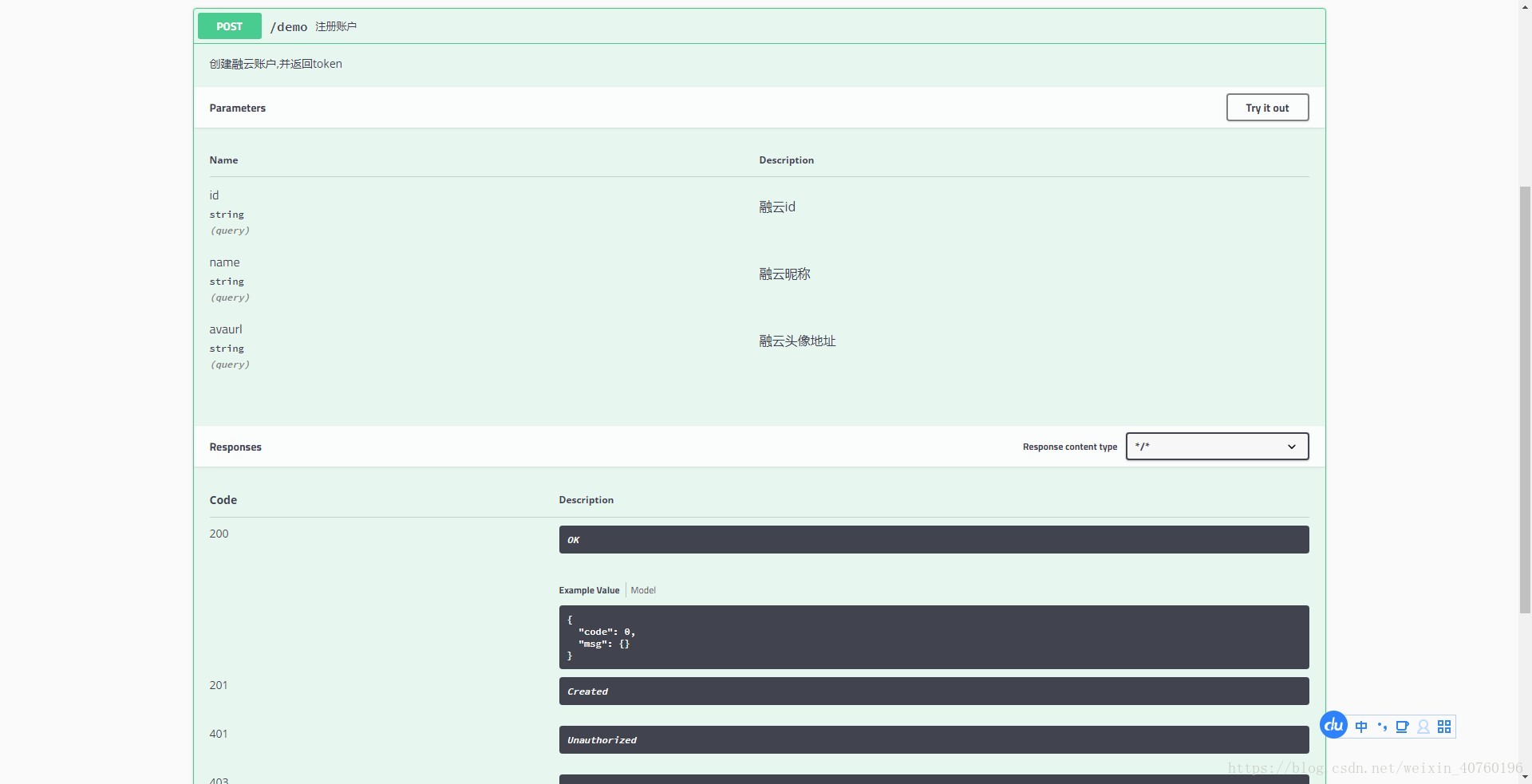以前的api文档都用的是sosoApi写的,感觉太麻烦了,现在使用springboot集成swagger2来构建RESTful API文档,可以在访问接口上,直接添加注释.简化一下操作
首先要引入2个包,如下:
<!-- swagger2核心包 -->
<dependency>
<groupId>io.springfox</groupId>
<artifactId>springfox-swagger2</artifactId>
<version>2.9.2</version>
</dependency>
<!-- swagger2 ui包 尽量与核心包一致-->
<dependency>
<groupId>io.springfox</groupId>
<artifactId>springfox-swagger-ui</artifactId>
<version>2.9.2</version>
</dependency>第二步,配置swagger2,由于springboot不再写配置文件.我们需要
//注解开启 swagger2 功能
@EnableSwagger2
//注解标示,这是一个配置类,@Configuation注解包含了@Component注解
//可以不用在使用@Component注解标记这是个bean了,
@Configuration
public class Swagger2 {
/**
* 通过 createRestApi函数来构建一个DocketBean
* 函数名,可以随意命名,喜欢什么命名就什么命名
*/
@Bean
public Docket createRestApi() {
return new Docket(DocumentationType.SWAGGER_2)
.apiInfo(apiInfo())//调用apiInfo方法,创建一个ApiInfo实例,里面是展示在文档页面信息内容
.select()
//控制暴露出去的路径下的实例
//如果某个接口不想暴露,可以使用以下注解
//@ApiIgnore 这样,该接口就不会暴露在 swagger2 的页面下
.apis(RequestHandlerSelectors.basePackage("com.sifangyuan.rongcloud.web"))
.paths(PathSelectors.any())
.build();
}
//构建 api文档的详细信息函数
private ApiInfo apiInfo() {
return new ApiInfoBuilder()
//页面标题
.title("云行一")
//创建人
.contact("刘星")
//版本号
.version("1.0")
//描述
.description("API 描述")
.build();
}
第三步就是开始定义自己的接口了
@ApiOperation(value = "注册账户",notes = "创建融云账户,并返回token")
@ApiImplicitParams({
@ApiImplicitParam(name = "id",value = "融云id",dataType = "string"),
@ApiImplicitParam(name = "name",value = "融云昵称",dataType = "string"),
@ApiImplicitParam(name = "avaurl",value = "融云头像地址",dataType = "string")
})
@PostMapping("demo")
public ReslutInfo demo(String id,String name, String avaurl) throws Exception {
ReslutInfo register = tokenUtil.register(id, name, avaurl);
return register;
}
@ApiIgnore //此注解可以隐藏这个方法
@PostMapping("test")
public String testIgnore(){
return "success";
}然后可以看下成果了
访问http://localhost:8080/swagger-ui.html#/


常用注解:
- @Api()用于类;
表示标识这个类是swagger的资源
- @ApiOperation()用于方法;
表示一个http请求的操作
- @ApiParam()用于方法,参数,字段说明;
表示对参数的添加元数据(说明或是否必填等)
- @ApiModel()用于类
表示对类进行说明,用于参数用实体类接收
- @ApiModelProperty()用于方法,字段
表示对model属性的说明或者数据操作更改
- @ApiIgnore()用于类,方法,方法参数
表示这个方法或者类被忽略
- @ApiImplicitParam() 用于方法
表示单独的请求参数
- @ApiImplicitParams() 用于方法,包含多个 @ApiImplicitParam
具体使用举例说明:
@Api()
用于类;表示标识这个类是swagger的资源
tags–表示说明
value–也是说明,可以使用tags替代
但是tags如果有多个值,会生成多个list
@Api(value="用户controller",tags={"用户操作接口"})
@RestController
public class UserController {
}效果图:
@ApiOperation() 用于方法;表示一个http请求的操作
value用于方法描述
notes用于提示内容
tags可以重新分组(视情况而用)
@ApiParam() 用于方法,参数,字段说明;表示对参数的添加元数据(说明或是否必填等)
name–参数名
value–参数说明
required–是否必填
效果图:
@ApiModel()用于类 ;表示对类进行说明,用于参数用实体类接收
value–表示对象名
description–描述
都可省略
@ApiModelProperty()用于方法,字段; 表示对model属性的说明或者数据操作更改
value–字段说明
name–重写属性名字
dataType–重写属性类型
required–是否必填
example–举例说明
hidden–隐藏
@ApiModel(value="user对象",description="用户对象user")
public class User implements Serializable{
private static final long serialVersionUID = 1L;
@ApiModelProperty(value="用户名",name="username",example="xingguo")
private String username;
@ApiModelProperty(value="状态",name="state",required=true)
private Integer state;
private String password;
private String nickName;
private Integer isDeleted;
@ApiModelProperty(value="id数组",hidden=true)
private String[] ids;
private List<String> idList;
//省略get/set
} @ApiOperation("更改用户信息")
@PostMapping("/updateUserInfo")
public int updateUserInfo(@RequestBody @ApiParam(name="用户对象",value="传入json格式",required=true) User user){
int num = userService.updateUserInfo(user);
return num;
}效果图:

@ApiIgnore()用于类或者方法上,可以不被swagger显示在页面上
比较简单, 这里不做举例
@ApiImplicitParam() 用于方法
表示单独的请求参数
@ApiImplicitParams() 用于方法,包含多个 @ApiImplicitParam
name–参数ming
value–参数说明
dataType–数据类型
paramType–参数类型
example–举例说明
@ApiOperation("查询测试")
@GetMapping("select")
//@ApiImplicitParam(name="name",value="用户名",dataType="String", paramType = "query")
@ApiImplicitParams({
@ApiImplicitParam(name="name",value="用户名",dataType="string", paramType = "query",example="xingguo"),
@ApiImplicitParam(name="id",value="用户id",dataType="long", paramType = "query")})
public void select(){
}效果图:
参考文献:https://blog.youkuaiyun.com/u014231523/article/details/76522486























 1万+
1万+

 被折叠的 条评论
为什么被折叠?
被折叠的 条评论
为什么被折叠?








